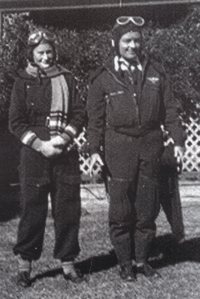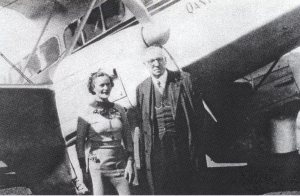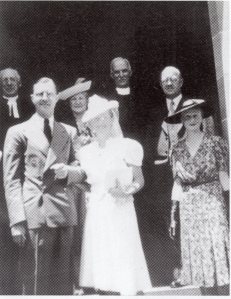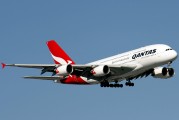Powerpoint presentation by Lynette Gleeson 12th April, 2010
From Macoboy’s ‘What Camellia is That’, this camellia japonica ‘was named for the aviatrix Nancy Bird by veteran Australian nurseryman Walter Hazlewood… a sport of ‘Jean Lyne’. The blooms are medium to large, semi-double and flushed a pale rose pink except at the petal edge, where there is a variable border of white. A few petaloids appear among the gold stamens, and occasional splashes of dramatic carmine-rose enliven an otherwise pastel flower—symbolic perhaps of Nancy Bird’s career’.
The ICS Register states ‘Waterhouse 1952, Camellia Trail p.18-24 as well as appearing in other publications such as Macoboy’s and ACRS News 1977.’
Nancy Bird was born on 16 October 1915 in Kew, NSW. She wanted to fly from before she could even properly pronounce the word ‘aeroplane.’ A popular memory is of how, as a 4 year old, she would jump off the back fence declaring that she was an ‘epiplane.’
When a WW1 aircraft made a forced landing at Dee Why Beach, Nancy just happened to be there to see it. As a teenager during the Depression in Australia, Nancy Bird left school to help out her family. Her brothers and sisters had stayed with their mother in Sydney, while she moved to the country with her father to work in his general store and be his housekeeper.
Nancy was 13 when there was an air pageant in Wingham. She had saved up enough money for a 10 shilling joy-flight and this reignited her passion for flying. She gave the pilot an additional £1, in exchange for the performance of some aerobatic manoeuvres. From that day on, her passion for flying escalated.
Charles Kingsford Smith opened a flying school at Mascot and Nancy Bird, who had met him prior to its opening, had told him then that she intended to become one of his students. Her father did not approve of his daughter’s plans, but did not forbid her to go. When she had saved up £200, she moved back to Sydney and lived with her mother. From there, she would travel to Mascot where she would begin flying lessons.
On 11 August 1933 Nancy commenced her flying lessons in a Gipsy Moth. Being small of stature, she sat on a pillow which enabled her to reach the controls and, in a little over a month, on 28 September she had earned her ‘A’ licence. To qualify for the licence it did not involve studying or training like it does today. They didn’t have runways, detailed maps, radios or even brakes. The plane to be taken down to 1500 feet before the pilot turned off the engine and glided the aircraft in a succession of turns safely back to the ground.
In that same year she obtained her ‘Advanced A’ pilot’s licence and in the following year, at the age of 19, she earned her title as Australia’s youngest commercial licensed female pilot.
Flying as a mode of transport was very unpopular during this time and every time that there was a crash, the public became nervous and airline companies regularly went broke.
‘Barnstorming’ helped pilots to make a living out of flying. This was where pilots flew to the shows and racecourses of country towns, landing in nearby paddocks to attract the attention of potential paying customers. Many townsfolk had never even seen an aeroplane before, let alone ridden in one.
Immediately after obtaining her commercial licence, Nancy and her co-pilot Peggy Mckillop who had finished her training at the same time, embarked on their own barnstorming tour—Australia’s first ‘Ladies Flying Tour.’ They charged the same price that Nancy had paid for her first flight, 10 shillings! This amount allowed them to cover their expenses, but not much else. The plane they flew while barnstorming was a Gipsy Moth. It had been given to Nancy as a gift by her Aunt Annie and her father, who now gave her his full support.
In 1935, Nancy was recruited by Rev. Stanley Drummond, to fly the clinic sisters to the stations and settlements west of Bourke. She maintained a strong commitment to Royal Far West until her death.
Also in 1935 a travelling dental clinic was established and the Drummond Far West Home was officially opened. She took out a loan to upgrade to a Leopard Moth aeroplane which cost £1800, and began working from Bourke for the Far West Service. With a better equipped aircraft she worked territory not previously covered by the Flying Doctor Service in remote parts of New South Wales. She enjoyed it, but was always mindful that if she became lost in such parts, it might be a long time before she was found.
Nancy took out the Ladies Trophy in the 1936 air race from Adelaide to Brisbane.
Flying in those days was stressful and Nancy needed a break. That break came in 1938 when she was invited by Dutch East Indies airline to travel the world studying aviation, in return for some promotional work for them. She sold her aircraft and took up the offer, knowing that she would never have been able to afford this opportunity by herself. While in France, she attended the Paris Aviation Exhibition. There they were showing a prototype aircraft which was, unbeknown to her at the time, capable of enormous destruction and would later be used in World War II.
On a ship travelling from America in 1939, Nancy met the man who would become her husband, Charles Walton.
During World War II, Nancy turned her attention to assisting Australia’s war efforts. No longer having a pilot’s licence, she couldn’t fly. This did not matter as no women pilots were allowed to fly in Australia during the War. She became Commandant of the Women’s Air Training Corps of Australia, and helped in recruiting and training women to serve in an auxiliary air force in case they were needed.
After World War II ended, they had two children, Anne Marie and John, and eventually became the grandmother of four.
In 1950, Nancy formed the Australian Women’s Pilot Association and became its president. Not wanting to be the president of a pilot’s association when she could not fly, she renewed her private licence in 1958. She then went on to be the first woman from overseas to compete in several of the all-women ‘Powder Puff Derbys’ in the United States.
In her latter years she published her autobiographies Born to fly, in 1961 and My God! It’s a Woman, in 1990, the title of her last book coming from a telephone conversation. As told by Nancy, “in 1936 I was the only charter pilot in Cunnamulla. Charles Russell, a well-known grazier, was visiting one of his properties when he was marooned by flood waters. I walked into his agent’s office just as Charles was being told by phone that an aircraft was being sent to rescue him. The agent told Charles to give the pilot landing instructions, and then handed me the phone. I took the receiver and said “Hello”. There was a stunned silence and then a horrified voice uttered, “My God It’s a woman”.
The people of the far west didn’t forget the work that Nancy had done for them and the new airport terminal at Bourke was named after her.
She was named a Living National Treasure by the National Trust in 1997.
It was on her 90th birthday that she was informed by Qantas that they were calling their future Super Jumbo A380 airbus ‘Nancy Bird Walton’. She was determined to be there for the christening on 30 Sept 2008. During her State Funeral on 21 January 2009, the roar of the engines of that airbus were heard as it flew over St Andrew’s Cathedral in honour of Australia’s pioneer woman aviator.
I met Nancy Bird Walton and took her photo at the National Camellia Show at Gordon in 2008. I told her I was doing a presentation on E.G. Waterhouse and his camellias, and I would like a photograph of her to put with the photo of her camellia namesake. “I would be delighted” was her reply. A very gracious lady.
ACKNOWLEDGMENTS
My God! It’s a Woman – Nancy Bird
http://www.airplane-pictures.net
http://www.australianbiography.gov.au
Camellias Australia Image Library
ICS
















Leave a comment